可数名词复数表格
- 格式:docx
- 大小:15.33 KB
- 文档页数:1

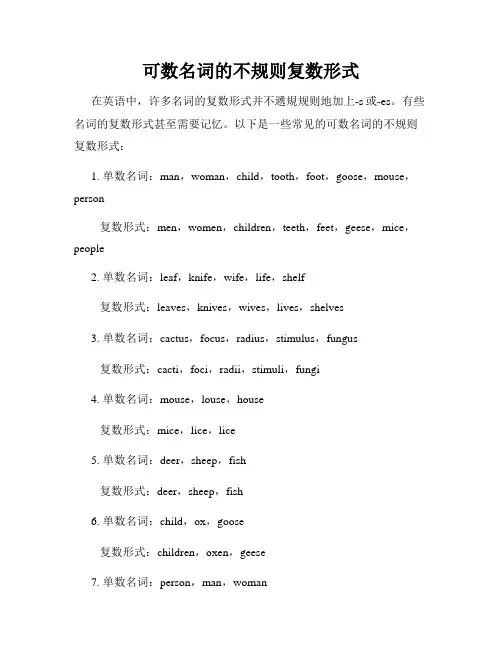
可数名词的不规则复数形式在英语中,许多名词的复数形式并不遞規规则地加上-s或-es。
有些名词的复数形式甚至需要记忆。
以下是一些常见的可数名词的不规则复数形式:
1. 单数名词:man,woman,child,tooth,foot,goose,mouse,person
复数形式:men,women,children,teeth,feet,geese,mice,people
2. 单数名词:leaf,knife,wife,life,shelf
复数形式:leaves,knives,wives,lives,shelves
3. 单数名词:cactus,focus,radius,stimulus,fungus
复数形式:cacti,foci,radii,stimuli,fungi
4. 单数名词:mouse,louse,house
复数形式:mice,lice,lice
5. 单数名词:deer,sheep,fish
复数形式:deer,sheep,fish
6. 单数名词:child,ox,goose
复数形式:children,oxen,geese
7. 单数名词:person,man,woman
复数形式:people,men,women
8. 单数名词:tooth,foot
复数形式:teeth,feet
9. 单数名词:leaf,calf,half,knife,life,loaf,elf
复数形式:leaves,calves,halves,knives,lives,loaves,elves 在学习英语的过程中,掌握这些可数名词的不规则复数形式是非常重要的。
希望以上内容能帮助大家更好地理解和掌握英语语言中的规则和不规则复数形式。
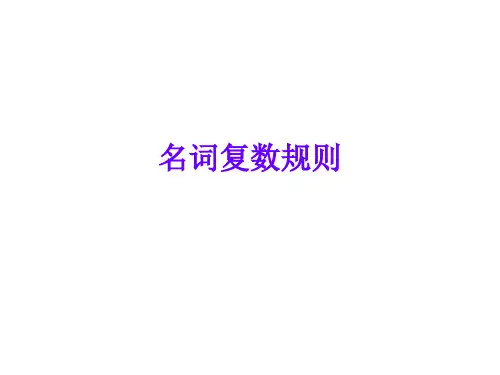
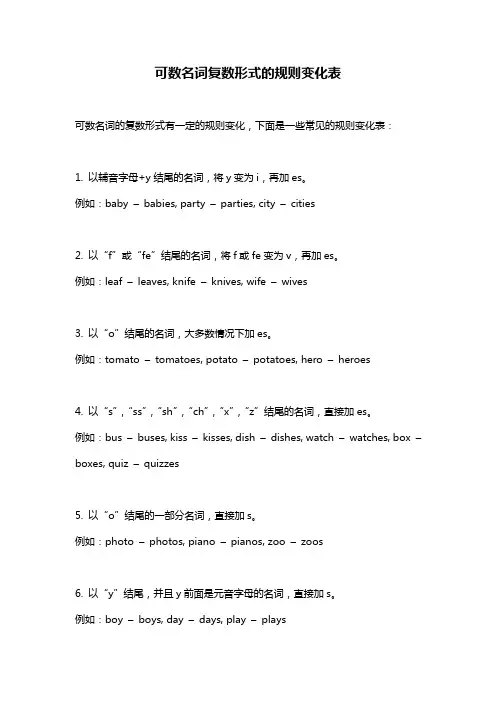
可数名词复数形式的规则变化表可数名词的复数形式有一定的规则变化,下面是一些常见的规则变化表:1. 以辅音字母+y结尾的名词,将y变为i,再加es。
例如:baby –babies, party –parties, city –cities2. 以“f”或“fe”结尾的名词,将f或fe变为v,再加es。
例如:leaf –leaves, knife –knives, wife –wives3. 以“o”结尾的名词,大多数情况下加es。
例如:tomato –tomatoes, potato –potatoes, hero –heroes4. 以“s”,“ss”,“sh”,“ch”,“x”,“z”结尾的名词,直接加es。
例如:bus –buses, kiss –kisses, dish –dishes, watch –watches, box –boxes, quiz –quizzes5. 以“o”结尾的一部分名词,直接加s。
例如:photo –photos, piano –pianos, zoo –zoos6. 以“y”结尾,并且y前面是元音字母的名词,直接加s。
例如:boy –boys, day –days, play –plays7. 以“us”结尾的名词,将us变为i。
例如:cactus –cacti, fungus –fungi, nucleus –nuclei8. 以“is”结尾的名词,将is变为es。
例如:analysis –analyses, basis –bases, crisis –crises需要注意的是,还有一些名词的复数形式是不规则的,需要单独记忆,例如:man –men, woman –women, child –children, tooth –teeth等。
记住这些规则,能够帮助你更好地理解和使用英语中的可数名词的复数形式。
在学习过程中,可以通过阅读、写作和听力练习来加深对这些规则的掌握。
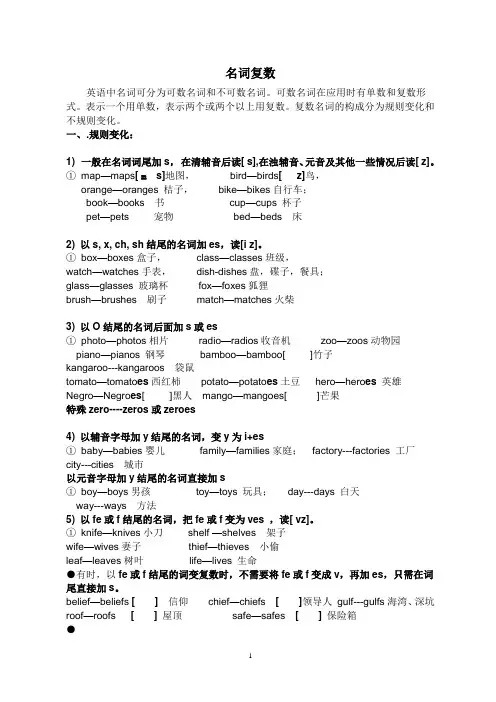
名词复数英语中名词可分为可数名词和不可数名词。
可数名词在应用时有单数和复数形式。
表示一个用单数,表示两个或两个以上用复数。
复数名词的构成分为规则变化和不规则变化。
一、.规则变化:1) 一般在名词词尾加s,在清辅音后读[ s],在浊辅音、元音及其他一些情况后读[ z]。
①map—maps[ m s]地图,bird—birds[ z]鸟,orange—oranges 桔子,bike—bikes自行车;book—books 书cup—cups 杯子pet—pets 宠物bed—beds 床2) 以s, x, ch, sh结尾的名词加es,读[i z]。
①box—boxes盒子,class—classes班级,watch—watches手表,dish-dishes盘,碟子,餐具;glass—glasses 玻璃杯fox—foxes狐狸brush—brushes 刷子match—matches火柴3) 以O结尾的名词后面加s或es①photo—photos相片radio—radios收音机zoo—zoos动物园piano—pianos 钢琴bamboo—bamboo[ ]竹子kangaroo---kangaroos 袋鼠tomato—tomato es西红柿potato—potato es土豆hero—hero es英雄Negro—Negro es[ ]黑人mango—mangoes[ ]芒果特殊zero----zeros或zeroes4) 以辅音字母加y结尾的名词,变y为i+es①baby—babies婴儿family—families家庭;factory---factories 工厂city---cities 城市以元音字母加y结尾的名词直接加s①boy—boys男孩toy—toys 玩具;day---days 白天way---ways 方法5) 以fe或f结尾的名词,把fe或f变为ves ,读[ vz]。

可数名词的复数形式名词按其所表示的事物的性质分为可数名词与不可数名词,然而可数名词又分为单数和复数两种形式,名词复数构成形式的部分规则如下:一.规则变化:1.cake --- cake s day --- day s student ---- student s总结:一般情况,直接加–s例题:apple bookpen cup2.bus – bus es box – box es watch – watch es wish – wish es 总结:以-s, -x, -sh, -ch等结尾的词,加es.例题:glass match{dish brush3.baby – bab ies city – cit ies country – countr ies总结:以辅音字母加y结尾的词,把y改i, 再加—es.例题:lady dictionary4.toy – toy s monkey – monkey s总结:以元音字母加y 结尾的词,直接加s.例题:key boy5.leaf – lea ves wolf – wol ves belief – belief s总结:1) 以f或fe 结尾的词,变f(fe) 为ves.一个贼(thief)的妻子(wife)冒着生命(life)危险用半(half)片树叶(leaf)似的小刀(knife)杀死了一只狼(wolf)]例题:thief wifelife halfknife wolf2) 但有些直接加sbelief roofproof chief6.face – face s orange – orange s price – price s总结:以ce, se, ze, (d)ge等结尾的词,加s。
例题:science languagebridge7..8.Negro – Negroes hero – heroes总结: 1)以o结尾的名词,有些词在词尾加上-es,简单记忆:黑人英雄爱吃土豆和西红柿。

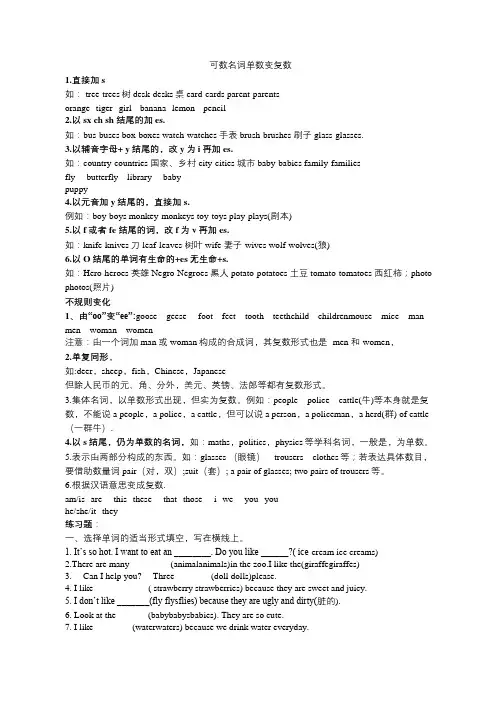
可数名词单数变复数1.直接加s如: tree-trees树 desk-desks桌 card-cards parent-parentsorange--tiger--girl-- banana--lemon-- pencil--2.以sx ch sh 结尾的加es.如:bus-buses box-boxes watch-watches 手表 brush-brushes 刷子 glass-glasses.3.以辅音字母+ y结尾的,改y为i再加es.如:country-countries 国家、乡村 city-cities 城市 baby-babies family-familiesfly--- butterfly---library--- baby---puppy---4.以元音加y结尾的,直接加s.例如:boy-boys monkey-monkeys toy-toys play-plays(剧本)5.以f或者fe 结尾的词,改f为v再加es.如:knife-knives刀 leaf-leaves 树叶 wife 妻子-wives wolf-wolves(狼)6.以O结尾的单词有生命的+es无生命+s.如:Hero-heroes 英雄 Negro-Negroes 黑人 potato-potatoes 土豆 tomato-tomatoes 西红柿;photo-photos(照片)不规则变化1、由“oo”变“ee”:goose---geese foot---feet tooth---teethchild---childrenmouse---mice man---men woman---women注意:由一个词加 man 或 woman构成的合成词,其复数形式也是 -men 和-women,2.单复同形,如:deer,sheep,fish,Chinese,Japanese但除人民币的元、角、分外,美元、英镑、法郎等都有复数形式。
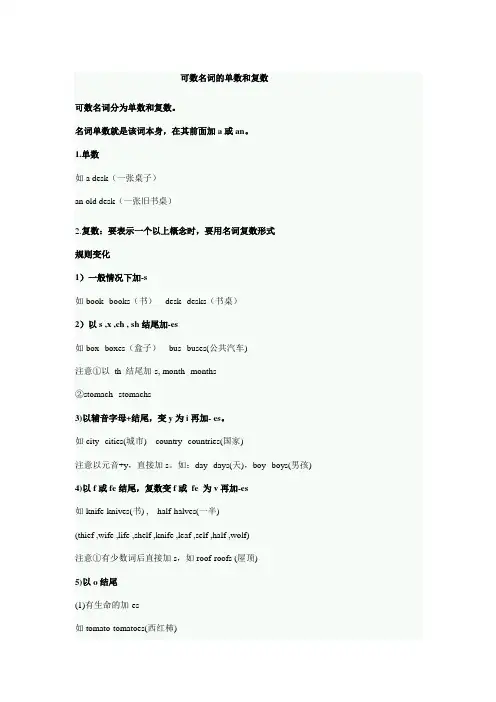
可数名词的单数和复数可数名词分为单数和复数。
名词单数就是该词本身,在其前面加a或an。
1.单数如a desk(一张桌子)an old desk(一张旧书桌)2.复数:要表示一个以上概念时,要用名词复数形式规则变化1)一般情况下加-s如book--books(书)desk--desks(书桌)2)以s ,x ,ch , sh结尾加-es如box--boxes(盒子)bus--buses(公共汽车)注意①以th 结尾加-s, month--months②stomach--stomachs3)以辅音字母+结尾,变y为i再加- es。
如city--cities(城市) country--countries(国家)注意以元音+y,直接加s。
如:day--days(天),boy--boys(男孩) 4)以f或fe结尾,复数变f或fe 为v再加-es如knife-knives(书) , half-halves(一半)(thief ,wife ,life ,shelf ,knife ,leaf ,self ,half ,wolf)注意①有少数词后直接加s,如roof-roofs (屋顶)5)以o结尾(1)有生命的加-es如tomato-tomatoes(西红杮)potato-potatoes(土豆)(2)无生命的加-s如piano-pianos (钢琴), zoo-zoos(动物园)photo-photos (照片), kangaroo-kangaroos(袋鼠)kilo-kilos(千克)不规则变化1)元音字母发变化。
如man--men(男人),woman--women(妇女)tooth--teeth(牙齿) ,foot--feet(脚)mouse--mice(老鼠) ,policeman--policemen(警察)policewoman--policewomen(女警察)2)词尾发生变化。
如child--children(小孩) ,ox--oxen(公牛)3)单、复数形式相同。

英语可数名词复数变化规则在公众号里输入关键字"英语规则"或"yygz"可跳转到该文章.一般情况下在名词后面加s。
读音变化:结尾是清辅音读[s],结尾是浊辅音或元音读[z]。
1 antibiotic antibiotics2 apple apples3 appurtenance appurtenances4 archive archives5 asset assets6 bag bags7 bed beds8 bike bikes9 bird birds10 book books11 brother brothers12 buttocks buttockss13 car cars14 cat cats15 chopstick chopsticks16 cloud clouds17 cosmetic cosmetics18 cup cups19 desk desks20 flower flowers21 forefather forefathers22 friend friends23 game games24 German Germans25 girl girls26 hat hats27 holiday holidays28 house houses29 human humans30 license licenses31 map maps32 mountain mountains33 mouth mouths34 orange oranges35 path paths36 piece pieces37 premise premises38 proceeding proceedings39 provision provisions40 qualification qualifications41 qualm qualms42 reminiscence reminiscences43 saving savings44 share shares45 shave shaves46 shoe shoes47 snip snips48 spectacle spectacles49 sport sports50 spot spots51 store stores52 strait straits53 student students54 style styles55 tactic tactics56 torrent torrents57 tree trees58 vicissitude vicissitudes59 Walkman Walkmans以s、z、x、ch(tʃ)、sh结尾的名词加es。

六年级英语词类,句子复习,可数名词的复数形式:bus---buses box---boxes fox---foxesdish---dishes class---classes glass---glassesdress-dresses peach---peaches watch---watches cloth---clothes brush---brushes potato---potatoes tomato---tomatoes photo---photos piano---pianos family---families library---libraries dictionary---dictionaries lady —ladies baby---babies boy---boysleaf---leaves shelf---shelves wolf---wolves knife---knives man---men woman---women foot---feet tooth---teeth goose---geesemouse---micesheep---sheeppeople---peopledeer---deer fish---fish(fishes) Chinese---Chinese child —children butterfly---butterflies policeman---policemen policewoman---policewomen 代词和 BE 动词复数形式:this —these that —those he, he, it —theyis, am —arewas —were二,现在进行时动词的 ing 形式或该动词的动名词形式 .动词现在分词详解 动词 的ing 形式的构成规则 :① 一般的直接在后面加上 ing , 如 doing , going , working , singing , eating ② 以 e 结尾的动词 , 要先去 e 再加 ing , 如 having , writing③ 双写最后一个字母的 (此类动词极少 ) 有 :running , swimming , sitting ,getting :四:一般过去时动词的过去式:动词过去式详解 动词的过去式的构成规则有 : A,规则动词① 一般直接在动词的后面加 ed: 如 worked , learned , cleaned , visited ② 以e 结尾的动词直接加 d:如lived , danced , used③ 以辅音字母加y 结尾的动词要改y 为i 再加ed (此类动词较少)如study -write---writing make---making take---taking have---havingsee---seeingrun---running get---getting ski---skiing swim---swimming put---putting 般现在时动词的第三人称单数形式:skate---skating leave---leaving sing---singing sit---sitting stop---stoppingfly---flies watch---watches don 't---doesn't play---playsstudy---studies teach---teaches go---goes have---haswash---washes do---does cry---criesstudied carry -carried worry -worried (注意play,stay 不是辅音字母力卩y,所以不属于此类)④ 双写最后一个字母(此类动词较少)如stopped (不规则动词)do---did don 't---didn 't go ---wentsee ---saw take---took swim---swambuy---bought read---read sing---sangeat ---ate have---had get---gotleave---left tell ---told say---saidam, is---was are---were run---rancome---came find ---found make---madestudy ---studied fly ---flew catch---caughtdrink---drank drive---drove give---gavehurt---hurt know---knew meet---metsend---sent sweep---swept hear---heardstand---stood sit---sat teach---taughtwrite---wrote tell—told row—rowed五:反义词或对应词big---small long---short tall---shortyoung---old strong---thin active---quietstrict---kind happy---sad clean---dirtygood---bad left---right cheap---expensivehot---cold warm---cool free---busysick---healthy same---different come---goin---out on---under behind---infront ohere---there far---near this---thatthese---those man---woman boy---girlwhite---black spring---fall summer---wintersouth---north east---west sweet---sour六:同音词1.buy by 2.two to 3.no know 4.I eye 5.son sun 6.who 'swhose7.father farther 8.aren 'taunt 9.sea see 10.right write 11.hi high12.pear pair 13.for four七,形容词比较级详解当我们需要对事物作出比较时,需要用到比较级.比较级的句子结构通常是什么+ 动词be (am , is , are ) + 形容词比较级+ than(比)+ 什么,如:I'm taller and heavier than you. (我比你更高和更重.)An elephant is bigger than a tiger. (一只大象比一只老虎更大.)形容词的比较级是在形容词的基础上变化而来的,它的变化规则是:①一般的直接在词尾加er , 如tall - taller , strong - stronger ,②以e结尾的,直接加r ,如fine -finer ,③以辅音字母加y结尾的,先改y为i再加er,如funny - funnier④双写最后的字母再加er,如big -bigger, thin -thinner ,hot -hotter☆注意☆比较的两者应该是互相对应的可比较的东西.典型错误:My hair is Ion ger than you.(我的头发比你更长.)比较的两者是我的头发,你(整个人),那么比较的对象就没有可比性.应该改为:My hair is Ion ger tha n yours. 或My hair is Ion ger tha n your hair. 八,人称代词与物主代词一、人称代词、物主代词九,同义词:l.what for why 2.a lot of many 3.whe n what time 八:基数词和序数词one---first two---second three---thirdfour---fourth five---fifth nine---ninth twelve--twelfthtwenty--twentieth thirty-one —thirty —first forty fifty月份(months): Jan. (January) —月Feb.(February)二月Mar.(March)三月April 四月May 五月June 六月July 七月Aug.(August) 八月Sept.(September) 九月Oct.(October) 十月Nov.(November) 十一月Dec.(December) 十二月日期写法:五月一日May 1st ( 读法:the first of may 或May first)六月二日June 2nd ( 读法:the second ofJune )七月三日July 3rd (读法:the third of July)十,句型专项归类1,肯定句:是指用肯定的语气来陈述的句子,如:I'm a student. She is a doctor. 2,否定句:含有否定词或表示否定意义词的句子,如He does not (doesn't) work in a hospital. There are not (aren't) four fans in our classroom.☆注意☆小结:否定句主要是在肯定句的基础上加上了否定词"not".有动词be 的句子则"not"加在be后面,可缩写成"isn't,aren't",但am not —般都分开写.没有动词be 的句子则要先在主要动词的前面加上一个助动词(do,does,did), 然后在它后面加上"not", 你也可以把它们缩写在一起如"don't , doesn't , didn't ).这三个助动词要根据人称和时态来选择,其中"does"只用于一般现在时主语是第三人称单数的情况,而"did"只用于一般过去时,不论主语是什么人称和数,都用"did".3,—般疑问句:是指询问事实的句子,此类句子必须用"yes",或"no"来回答.如:Are you a student Yes, I am / No, I'm not.Is she a doctor Yes, she is. / No, she isn't.Does he work in a hospital Yes, he does. / No, he doesn'tWill he eat lunch at 12:00 Yes, I will. / No, I will not(won't).☆注意☆小结:一般疑问句是在肯定句的基础上,①把动词be调到首位,其他照写,末尾标点符号变成问号即可.②没有动词be 的句子(有动词的句子)则要在句首加上一个助动词(do,does,did) 再把紧跟在后面的动词变回原形,末尾标点符号变成问号即可. 这三个助动词也要根据人称和时态来选择,其中"does"只用于一般现在时主语是第三人称单数的情况,而"did"只用于一般过去时,不论主语是什么人称和数,都用"did" . 一般疑问句有个重要的原则就是问和答要一致,即问句里的第一个单词(助动词)和简略答句里的这个词是一致的.☆ 4,特殊疑问句:以特殊疑问词(what , where , who , which , when , whose , why , how 等)开头引导的句子.此类句子应该问什么就答什么,不能用"yes ,no"来回答.。
可数名词的复数形式复数名词主语时系动词用are,单数名词主语时系动词用is.名词可分为可数名词和不可数名词两大类。
可数名词,有单复数之分,而不可数名词没有复数形式,可数名词变复数时有规则和不规则变化两种名词复数的规则变化:1.通常在单数名词后加:s构成复数day---days 天dog---dogs 狗house---houses 房屋car---cars 车2. 以字母o,S,x,ch,sh结尾的单数名词,在词尾加:es构成复数tomato---tomatoes 西红柿kiss---kisses 吻class—classes 班级box---boxes 箱,盒church---churches 教堂watch---watches 手表brush---brushes 刷子brush---brushes 刷子3. 辅音字母+y结尾的普通句词,先把y去掉再加ies构成复数baby---babies 婴儿Country---countries 国家fly---flies 苍蝇lady---ladies 女士city---cities 城市以y结尾但y前为元音的名词在构成复数时,在词尾直接加:s 构成复数boy---boys 男孩day---days 天guy---guys 家伙4. 以字母o结尾的外来词或缩写词的名词,在词尾加:s构成复数dynamo---dynamos 发电机kilo---kilos 公斤kimono---kimonos 和服photo---photos 照片piano—pianos 钢琴soprano---sopranos 女高音歌手5. 有12个以f或fe结尾的名词在构成复数时,去掉f或fe加ves calf小牛half半knife刀leaf叶子life生命loaf(面包的)条/只self自身sheaf捆shelf架子thief贼wife妻子wolf狼名词复数的不规则变化:有些名词用改变元音的方法来构成其复数形式foot---feet 英尺,脚tooth---teeth 牙齿goose---geese 鹅louse---lice 虱子mouse---mice 老鼠man---men 男人woman---women 女人名词的复习学案名词可分为可数名词和不可数名词两大类。
六年级英语词类,句子复习一,可数名词的复数形式:bus---buses box---boxes fox---foxesdish---dishes class---classes glass---glassesdress-dresses peach---peaches watch---watchescloth---clothes brush---brushes potato---potatoestomato---tomatoes photo---photos piano---pianosfamily---families library---libraries dictionary---dictionaries lady—ladies baby---babies boy---boysleaf---leaves shelf---shelves wolf---wolvesknife---knives man---men woman---womenfoot---feet tooth---teeth goose---geesemouse---mice sheep---sheep people---peopledeer---deer fish---fish(fishes) Chinese---Chinese child—children butterfly---butterfliespoliceman---policemen policewoman---policewomen代词和BE动词复数形式:this—these that—those he, he, it—theyis, am—are was—were二,现在进行时动词的ing形式或该动词的动名词形式.动词现在分词详解动词的ing形式的构成规则:①一般的直接在后面加上ing , 如doing , going , working , singing , eating②以e 结尾的动词,要先去e再加ing ,如having , writing③双写最后一个字母的(此类动词极少)有:running , swimming , sitting , getting:write---writing take---taking skate---skatingmake---making have---having leave---leavingsee---seeing ski---skiing sing---singingrun---running swim---swimming sit---sittingget---getting put---putting stop---stopping三,一般现在时动词的第三人称单数形式:fly---flies study---studies wash---washeswatch---watches teach---teaches do---doesdon’t---doesn’t go---goes cry---criesplay---plays have---has四:一般过去时动词的过去式:动词过去式详解动词的过去式的构成规则有:A,规则动词①一般直接在动词的后面加ed:如worked , learned , cleaned , visited②以e结尾的动词直接加d:如lived , danced , used③以辅音字母加y结尾的动词要改y为i再加ed(此类动词较少)如study –studied carry – carried worry – worried (注意play,stay不是辅音字母加y,所以不属于此类)④双写最后一个字母(此类动词较少)如stopped(不规则动词)do---did don’t---didn’t go ---wentsee ---saw take---took swim---swambuy---bought read---read sing---sangeat ---ate have---had get---gotleave---left tell ---told say---saidam, is---was are---were run---rancome---came find ---found make---madestudy ---studied fly ---flew catch---caughtdrink---drank drive---drove give---gavehurt---hurt know---knew meet---metsend---sent sweep---swept hear---heardstand---stood sit---sat teach---taughtwrite---wrote tell—told row—rowed五:反义词或对应词big---small long---short tall---shortyoung---old strong---thin active---quietstrict---kind happy---sad clean---dirtygood---bad left---right cheap---expensivehot---cold warm---cool free---busysick---healthy same---different come---goin---out on---under behind---in front ofhere---there far---near this---thatthese---those man---woman boy---girlwhite---black spring---fall summer---wintersouth---north east---west sweet---sour六:同音词1.buy by 2.two to 3.no know 4.I eye 5.son sun 6.who’s whose7.father farther 8.aren’t aunt 9.sea see 10.right write 11.hi high12.pear pair 13.for four七,形容词比较级详解当我们需要对事物作出比较时,需要用到比较级.比较级的句子结构通常是:什么+ 动词be (am , is , are ) + 形容词比较级+ than(比)+ 什么,如:I'm taller and heavier than you. (我比你更高和更重.)An elephant is bigger than a tiger. (一只大象比一只老虎更大.)形容词的比较级是在形容词的基础上变化而来的,它的变化规则是:①一般的直接在词尾加er ,如tall - taller , strong - stronger ,②以e结尾的,直接加r ,如fine – finer ,③以辅音字母加y结尾的,先改y为i再加er,如funny - funnier④双写最后的字母再加er,如big – bigger, thin – thinner ,hot – hotter☆注意☆比较的两者应该是互相对应的可比较的东西.典型错误:My hair is longer than you.(我的头发比你更长.)比较的两者是我的头发,你(整个人),那么比较的对象就没有可比性.应该改为:My hair is longer than yours. 或My hair is longer than your hair. 八,人称代词与物主代词九,同义词:1.what for why2.a lot of many3.when what time八:基数词和序数词one---first two---second three---thirdfour---fourth five---fifth nine---ninth twelve--twelfthtwenty--twentieth thirty-one—thirty—first forty fifty月份(months): Jan. (January)一月Feb.(February)二月Mar.(March)三月April 四月May五月June六月July七月Aug.(August)八月Sept.(September)九月Oct.(October)十月Nov.(November)十一月Dec.(December)十二月日期写法:五月一日May 1st ( 读法:the first of may 或May first)六月二日June 2nd ( 读法:the second ofJune )七月三日July 3rd (读法: the third of July)十,句型专项归类1.肯定句:是指用肯定的语气来陈述的句子,如:I'm a student. She is a doctor. 2,否定句:含有否定词或表示否定意义词的句子,如He does not (doesn't) work in a hospital. There are not (aren't) four fans in our classroom.☆注意☆小结:否定句主要是在肯定句的基础上加上了否定词"not".有动词be 的句子则"not"加在be后面,可缩写成"isn't,aren't",但am not 一般都分开写.没有动词be的句子则要先在主要动词的前面加上一个助动词(do,does,did),然后在它后面加上"not",你也可以把它们缩写在一起如"don't , doesn't , didn't ).这三个助动词要根据人称和时态来选择,其中"does"只用于一般现在时主语是第三人称单数的情况,而"did"只用于一般过去时,不论主语是什么人称和数,都用"did" .3,一般疑问句:是指询问事实的句子,此类句子必须用"yes",或"no"来回答.如:Are you a student Yes, I am / No, I'm not.Is she a doctor Yes, she is. / No, she isn't.Does he work in a hospital Yes, he does. / No, he doesn'tWill he eat lunch at 12:00 Yes, I will. / No, I will not(won't).☆注意☆小结:一般疑问句是在肯定句的基础上,①把动词be调到首位,其他照写,末尾标点符号变成问号即可.②没有动词be的句子(有动词的句子)则要在句首加上一个助动词(do,does,did)再把紧跟在后面的动词变回原形,末尾标点符号变成问号即可.这三个助动词也要根据人称和时态来选择,其中"does"只用于一般现在时主语是第三人称单数的情况,而"did"只用于一般过去时,不论主语是什么人称和数,都用"did" .一般疑问句有个重要的原则就是问和答要一致,即问句里的第一个单词(助动词)和简略答句里的这个词是一致的.☆4,特殊疑问句:以特殊疑问词(what , where , who , which , when , whose , why , how等)开头引导的句子.此类句子应该问什么就答什么,不能用"yes ,no"来回答.。
英语中名词可分为可数名词和不可数名词。
可数名词在应用时有单数和复数形式。
表示一个用单数,表示两个或两个以上用复数。
复数名词的构成分为规则变化和不规则变化。
1.规则变化:1) 一般在名词词尾加s,读音变化:结尾是清辅音读[s],结尾是浊辅音或元音读[z]。
例:map—maps地图,bird—birds鸟,orange—oranges 桔子,bike—bikes 自行车;bag—bags,pen—pens,desk—desks,worke—workers,friend→friends; cat→cats; style→styles; sport→sports; piece→pieces2) 以s、z、x、ch、sh结尾的名词,在该词末尾加上后辍-es构成复数。
读音变化:统一加读[iz]。
box—boxes盒子,class—classes班级,watch—watches手表,dish-dishes 盘、碟子、餐具,bus—buses,quiz—quizzes,fox—foxes,match—matches,flash—flashes;3) ①以辅音字母加y结尾的名词,变y为i+es.读音变化:加读[z]。
baby—babies婴儿,family—families家庭,city—cities,actory—actories,candy—candies; daisy—daisies; fairy—fairies; lady—ladies; story—stories②以元音字母加y结尾的名词直接加sboy—boys男孩toy—toys 玩具;4) 以fe或f结尾的名词,把fe或f变为ves.读音变化:尾音[f]改读[vz]。
knife—knives小刀,wife—wives妻子,leaf—leaves树叶,bookshelves反例:roof→roofs5) 以-o结尾的名词,如果不是外来词或缩写,一般加-es,否则加-s构成复数。
名词分可数名词和不可数名词1可数名词个体名词都是可数名词.每个可数名词都有其单数和复数形式.A.单数表示“一个”的概念.用名词的单数时,名词前需加a 或an.如a book(一本书)、a river (一条河)、an apple(一个苹果)、an orange(一个橘子)等.B.复数表示两个或两个以上的物体.如two pens(两枝钢笔)、three days(三天)、three cities (三个城市)等.复数形式的构成有两种:规则名词复数形式的构成和不规则名词复数形式的构成.具体见下表.规则名词复数形式的构成变为复数形式的构成方法在词尾加-s.(在清辅音后读,在浊辅音及元音后读[z].)cat——catsbag——bagsday——days以s、x、ch、sh 结尾的名词在词尾加-es,读作[iz].class——classesmatch——matches以辅音字母+y 结尾的名词把y 变成i ,加-es,读作[iz]city——cities但专有名词例外,直接在y后加-s,读作[z] Germany——Germanys以辅音字母+o 结尾的名词一般直接加-es ,读作[z]; 某些外来词例外,加-s (如zero,kilo,tobacco 等)tomato——tomatoesphoto——photospiano——pianos以元音字母+o 结尾的名词直接加-s,但读作[z] zoo——zoosradio——radios以f 或fe 结尾的名词有的直接加-s,读作[z]roof——roofs大多数要将f 或fe变为v,再加-es,读作[z] Leaf——leaveswife——wives有些词两种形式者可以handkerchief——handkerchiefs——handkerchieves 不规则名词复数形式的构成通过改变词内元音字母man——men foot——feettooth——teeth mouse——mice(老鼠)通过在词尾加-enox——oxen(牛child——children单复数形式相同a sheep——two sheepa deer——two deer(鹿)a Chinese——two Chinese(中国人)外来词保持其原有的复数形式crisis——crises(危机)basis——bases(基础)phenomenon——phenomena(现象)复合名词复数形式的构成变复数的方法由若干部分组成并含有一种中心词(指人的词)将中心词变为复数形式son-in-law (女婿)——sons-in-lawgrandchild(孙子)——grandchildrenlooker-on (旁观者)——lookers-on组成部分均为表示人的主体词各组成部分都要变为复数形式woman doctor(女医生)——women doctorman servant(男仆)——men servants组成部分没有中心词最后一个组成词上加-sgrown-up (成年人)——grown-upsgo-between(中间人)——go-betweens只有复数形式的名词由相同两部分组成的物体的名称scissors(剪刀)trousers(裤子)glasses(眼镜)以-ing 结尾的名词化的动名词savings(积蓄)earnings(工资)belongings(所有物)surroundings(周围环境)已约定俗成的名词形式arms(武器)stairs(楼梯)thanks(感谢)只有单数形式的名词如:advice(意见),labour(劳动),information(信息、消息),furniture (家具),traffic(交通).2 不可数名词表示无法分清个体的名词.不过,有些词在汉语中可数,在英语中却不可数.例如:news(新闻)、furniture(家具)、bread(面包)等.此类不可数名词要表示“一”这个概念时,需用其它方式表达,如 a piece of news,a piece of furniture,a loaf of bread 等.一般来说,物质名词和抽象名词是不可数的,通常没有复数形式,但有时为了表示“不同类”或“大量”时,可以用复数形式,例如:China is rich in waters.中国有丰富的水资源.分辨口诀:可数不可数好分辨;名词所示物分两半.如每半不能叫原名;那该词可数最公平.每半还能把原名叫;不可数名词就遇到.有的名词是两面堵;意变不可数为可数可数名词的复数形式名词按其所表示的事物的性质分为可数名词与不可数名词,然而可数名词又分为单数和复数两种形式,名词复数构成形式的部分规则如下:一.规则变化:1.cake --- cake s day --- day s student ---- student s总结:一般情况,直接加–s例题:apple bookpen cup2.bus – bus es box – box es watch – watch es wish – wish es 总结:以-s, -x, -sh, -ch等结尾的词,加es.例题:glass matchdish brush3.baby – bab ies city – cit ies country – countr ies总结:以辅音字母加y结尾的词,把y改i, 再加—es.例题:lady dictionary4.toy – toy s monkey – monkey s总结:以元音字母加y 结尾的词,直接加s.例题:key boy5.leaf – lea ves wolf – wol ves belief – belief s总结:1) 以f或fe 结尾的词,变f(fe) 为ves.一个贼(thief)的妻子(wife)冒着生命(life)危险用半(half)片树叶(leaf)似的小刀(knife)杀死了一只狼(wolf)例题:thief wifelife halfknife wolf2) 但有些直接加sbelief roofproof chief6.face – face s orange – orange s price – price s总结:以ce, se, ze, (d)ge等结尾的词,加s。